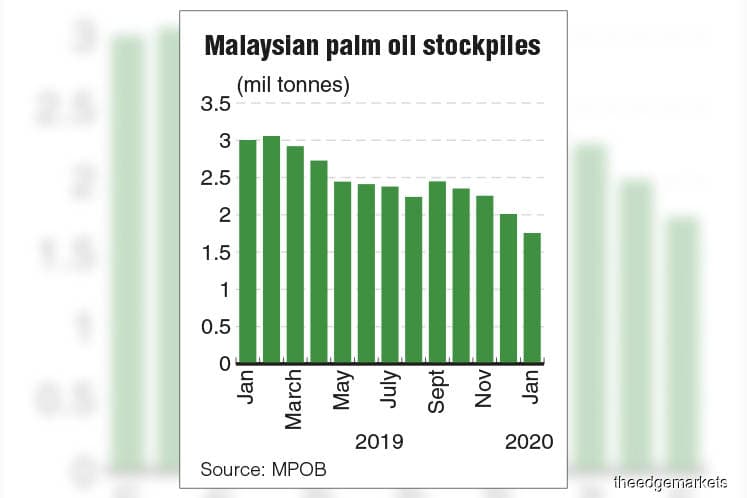
This article first appeared in The Edge Financial Daily on February 11, 2020
KUALA LUMPUR: Malaysian palm oil end-stocks fell for a fourth consecutive month in January to the lowest level in over two years, according to data released by the Malaysian Palm Oil Board (MPOB) yesterday.
Stocks as at end-January fell 12.7% month-on-month (m-o-m) to 1.76 million tonnes, well below the two million tonne-mark that was breached in September 2017. In December 2019, inventories stood at 2.01 million tonnes.
M-o-m production, meanwhile, fell 12.6% to 1.17 million tonnes in January, while exports decreased 13.2% from December to 1.21 million tonnes, MPOB figures showed.
CGS-CIMB Research regional head of agribusiness Ivy Ng said the January palm oil inventory figure came in above expectations and broadly in line with market expectations.
She commented that the lower stockpile is supportive of crude palm oil (CPO) prices as it suggests limited reserves, but cautioned that concerns about global growth and lower oil prices due to the Wuhan virus outbreak may limit the upside potential in the near term.
“There are concerns that the Wuhan virus may impact global growth, which will lead to weaker demand for edible oils. We project the CPO price to trade in the range of RM2,500 to RM2,800 per tonne in February,” Ng told The Edge Financial Daily when contacted.
Ng is also expecting production to remain weak due to the fewer working days and declining exports arising from a weaker demand from China and India.
She said the lower exports are partly due to relatively higher prices caused by the weaker supply, as there were less fertiliser applied when CPO prices were weak in 2018 and 2019 besides the dry weather in the third quarter (3Q) of 2019.
As at yesterday’s close, the benchmark palm oil futures contract for April delivery settled RM54 lower at RM2,759 a tonne. CPO futures prices have eased since their three-year peak of RM3,145 last month, but are up over 20% versus RM2,255 a year ago.
Meanwhile, Sathia Varqa, owner and co-founder of Singapore-based Palm Oil Analytics, pointed out that the January MPOB data was within market expectations, except for exports, which he said came in slightly lower than his lowest expected figure of 1.22 million tonnes.
“The lower stocks underpinned by lower output was priced-in in the market last week. Meanwhile, exports fell deeper than expected.
“There was a sharper-than-expected fall in shipment to India by 66% versus cargo surveyor data showing a 55% drop. But the drop in shipment to China by 31%, and increases to Pakistan and The Netherlands by 88% and 80% respectively, were consistent with expectations,” he said when contacted.
Varqa added that CPO prices are likely to be supported by the shrinking stockpile in the near term, but the prices should be weaker as production begins to pick up in 2Q and as exports to top buyers China and India are likely to be weak.
He sees benchmark palm oil prices trading between RM2,500 and RM2,700 with full-year average forecast at RM2,600.
Going forward, Public Investment Bank Bhd analyst Chong Hoe Leong believes that inventories should see more declines in the coming months due to the sharper drop in production despite seeing weaker demand from China and India.
On a positive note, there will be a surge in demand from Pakistan and other regional markets due to the realignment of supply chain, he said.
Nevertheless, Chong cautioned that the concerns about the spread of the virus could affect palm oil cargoes from Indonesia and Malaysia, which will eventually create a backlog for the next couple of months.
“We have a CPO price forecast of RM2,600 per tonne for 2020. The mounting concerns about the virus spread could hold up the deliveries of agricultural products due to transport restrictions and shortage of workers,” he added.